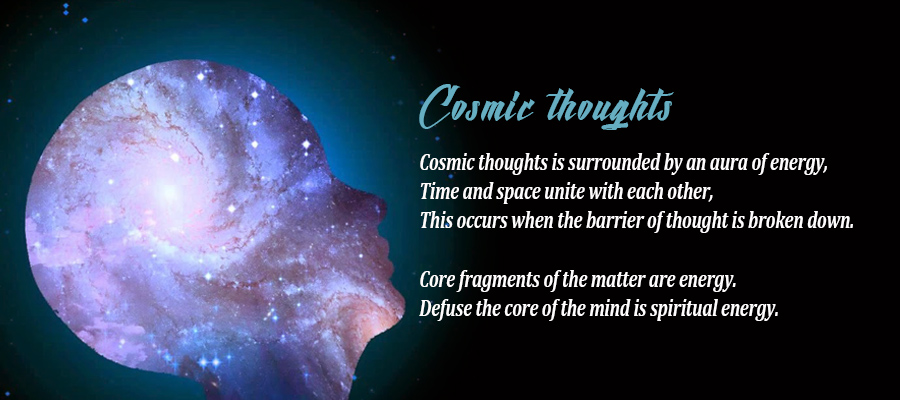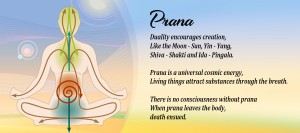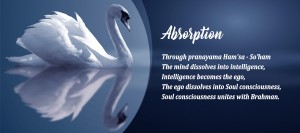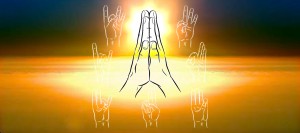The mind of an individual is a part of the cosmic universal mind. We must understand that our individual mind is part of the universal mind. The space in this room is an individual space, but it is also a part of greater space. Because you have four walls around it, you call it your room space. Similarly, the individual mind is a concept and not a reality. Actually, there is the only universal mind. The individual mind should not be brought into consideration at all. Our mind is a concept and in meditation, we have to blow it up.
What happens when you break the walls? where is the individual space? It becomes part of the total space. So the whole crux of the matter is the individualization of the mind which is actually a process of self-hypnotism.
The universal mind is symbolized by a cosmic egg. The shell of this egg is composed of proto-matter. At one end of this egg is Space, at the other end, Time. Space is the positive pole and Time is the negative pole. The center of the universal mind is Bindu, a point. That is the nucleus of the universal mind and it contains a form that we call matter. When you sit for meditation and start concentrating on one point, Time and Space both proceed towards the center. When they unite at the Bindu point, a great explosion of energy forces takes place.
This is what happens in the universal mind when you are practicing meditation. Where is this universal mind? The universal mind is in everyone because when the explosion takes place, the universal mind breaks into thousands of parts and millions of fragments. These fragments of the universal mind are absolute in nature. When we divide the absolute into millions, it remains absolute. The absoluteness of the absolute can never be altered.
Taking ‘one’ as the symbol of absolute, there can be nothing greater or lesser than ‘one’.
The shortest equation is 1+1=1 or 1-1=1 or 1×1=1or 1:1=1. That is the concept of the universal mind.
The universal mind is divided into millions and trillions of fragments and each fragment is absolutely universal in nature and structure. Therefore, every particle in this universe is part of the universal mind. When you practice meditation you are dealing with the universal mind, and when you are trying to concentrate on a point, you are bringing time and space into one polarity.
Beyond the frontiers of the mind
When we talk about the evolution of humans being, we are talking about his evolution in the outside world as well as the inside world. The cognition and perception of the mind are limited by its associations with the senses. The mind gains knowledge through the five sensory portals, and if these portals refuse to give information to the mind, the mind becomes incapacitated. If we had no eyes, the mind could not see. If we had no auditory system, the mind could not hear. That is how the mind is incapacitated in the absence of association with the senses. This means that the senses are the boundaries, the frontiers of the mind. Just as a house has a compound wall, so does the mind. Senses are the boundaries, the frontiers or compound walls for the mind.
By leading the mind into meditation, we take it beyond these frontiers. When we are able to do this, you experience an expansion of consciousness. During this state, the mind learns to see, hear, feel and know without the medium of the senses, and it becomes a very sensitive instrument in the hands of a human.
In our century, meditation has caught the attention of millions of people all over the world. Numerous systems of meditation have been devised and practiced by people in different countries and they have definitely brought many positive results. People are now convinced that meditation is a way to further spiritual evolution. But still many wonder if meditation is only a state of the brain and mind or is it something more?
Recently a lot of experiments have been conducted on the basis of chemical drugs, and many thinkers have come to the conclusion that the alteration of consciousness can be brought about by chemical means. Those who think that drugs can bring about a change in the state of the mind believe that meditation influences the cerebral structure in a similar way. But strictly and frankly speaking, meditation is a process in which not only your brain and nervous system but the whole personality from physical to spiritual, undergoes a metamorphosis.
When we practice pranayama with retention of the breath (Kumbhaka), there is some influence exerted on the silent areas of the brain. As a result, we may have psychic experiences, and when we sit for meditation, we may become completely unconscious of space and time. But usually, meditation is a process of expansion in which time and space are brought together at the nucleus of the self.
Matter and mind
The whole universal mind is encircled by an energy aura. When time and space unite with each other, a great phenomenon takes place as the point or nucleus of the universal mind undergoes an explosion.
Break the matter and the nucleus of the matter is energy. Break the mind and the nucleus of the mind is spiritual energy.
During the whole process of meditation, the universal mind is undergoing the same process, the same transformation as matter during the process of fission and fusion. We must clearly understand that matter and mind are two different states of one reality.
The central core of the mind and the central core of the matter is energy (shakti) and awareness is Purusha (Jiwa).
That is why, in the process of dhyana, the emphasis is placed on one-pointed concentration, on consistent and un-fluctuating awareness of one Bindu, one symbol. The symbol on which you meditate is only a support. When you achieve meditation the symbol is destroyed.
When we want to disintegrate the matter and derive nuclear energy from it, we take a particular form of matter. When we want to explore the mind, then we should give it a form. So some people meditate on a point or others have their own symbol. At a particular stage of meditation, the symbol explodes and then the state of Samadhi comes.
By purifying the mind through Karma yoga, it is possible to avoid the sudden rush of thoughts. But when we enter deep into the area of meditation we have other difficulties.
When the ordinary consciousness has been switched off completely, psychic experiences can occur and they may cause us to lose our point of concentration. These psychic experiences are so attractive, powerful and mind capturing, that we cannot ignore them, and most people’s spiritual journey ends at this point.
Self-hypnosis and psychic experiences
Often a state of self-hypnosis is misunderstood as meditation. Some people meditate to improve the quality of their sleep, to get rid of their alcoholic habits, or to harmonize their family or marital life. But frankly speaking, this is not the fruit of meditation. This is the fruit of self-hypnosis. It is said in the yogic scriptures as well as in the Gita, that generally when people try to concentrate they enter into a state of self-hypnosis. There are millions of unfortunate people on our planet who definitely need the help of self-hypnosis, but there comes a point in man’s evolution when he has to break out of his self-created boundaries.
Everything happens inside the mind and nothing happens outside. Behind the body is the mind, and behind the mind is the universal mind. Behind the universal mind is the universal spirit. It is difficult for people to realize that there could be anything beyond this body. If you ask them, ‘Where is your mind, your emotions, your hunger?’ They say, ‘Here’. But these things are not in the body. In fact, they are so distinct, so separate from the body, that they are completely isolated from it. The body is not even a vehicle for them.
As you progress along the path of meditation, you become more aware of the mind and identify less with the body. The mind is a very great force and in order to understand it fully, you need a correct and systematic way. Otherwise, when you close your eyes for meditation you may go into unconsciousness, deep, lucid sleep. In meditation, there should be total awareness within and without, and this total awareness has to be experienced by the practitioner.
Of course, during your meditation practice, there may be moments when you have psychic experiences. These experiences are indestructible patterns of a part of the universal mind. But they should never be taken for the fruit of meditation. One should not care for these psychic experiences even though they come during meditation practice. They are what I call obstacles. When the explosion takes place and everything becomes energy/matter, then the energy is in the form of a nebula and these high experiences are the nebulous manifestation of the universal mind. If you have a symbol or a point to focus your concentration on, you can ignore all experiences that may occur during the period of meditation.
In the earlier stages of meditation when you are trying to cancel your thinking, thoughts will come and go. You can use your willpower to put these thoughts aside, but if you are not so strong, then you will lose your point of concentration. If you are strong, you can hold onto the point of concentration and completely ignore the thoughts that come and go. However, even when you are doing this, a thought can enter the periphery of your awareness, without you even knowing it, and disturb the whole area of concentration. A strong person has this type of problem, and weak persons have other problems, particularly in trying to fix their minds on one point.
Homogeneous awareness
In higher states of meditation, one doesn’t retire from external experiences. There is a simultaneous awareness of both outside and inside that, you call a homogeneous experience. The external light is a manifestation of consciousness and therefore we cannot create a compartment between the so-called outside consciousness and inside consciousness. Consciousness is one, but we only know the external one and not the internal one. Consciousness in this sense is like an iceberg. You can only see a little bit on the top; you are not able to see what is beneath the surface of the ocean. In the highest state of meditation, one can perceive the whole consciousness.
In the highest meditation, there is awareness of total consciousness. In the initial states of meditation, you are only aware of the inner consciousness and you forget about the external one. In the preliminary stages of meditation, the outside experiences are blocked out. You hear no sounds, you see no forms, you know nothing outside. But as you go deep into the highest state of meditation, the consciousness begins to expand. It is something like standing at the threshold and being able to see inside the room and outside at the same time.
Very few people can understand this, because, for most people, the state of meditation is awareness of the inner consciousness. As you make progress in meditation, life becomes one and not two. Then you have no difficulty in maintaining a relationship and contact with both the inner and the outer lives. You are not like a fish who can live in water only, but like a turtle who can live in water as well as out of it. You are able to experience the inner spirit and the outer objective world at the same time. Only when this happens does samadhi occur, not before.
Meditation is a way for the evolution of the whole of mankind. If one person in a family is meditating he is able to create a resonance in the minds of the others at the same time. If you tune five violins and strike one, gradually the resonance will affect all the other violins and their strings will also vibrate. This is how the man will come nearer to his own existence and his own reality. The external life is not unreal and the internal life is not utopia. But external life in itself is not complete; internal life is the accomplishment of external life. Man’s commitment and fulfillment are only one, and that is meditation.
Meditation Practice
- Sit in any comfortable posture which can maintain without difficulty throughout the practice. Close eyes, and let the whole body become relaxed and steady. Keep the spine erect and place hands on the knees.
- Feel deep peace pervade the whole body and mind. Become aware of the natural breath; feel the air as it flows in and out of the nostrils.
- Contract the glottis slightly and begin to practice ujjayi pranayama. The breath should be natural and spontaneous rather than deep. Practice very soft ujjayi breathing so that only our-self can hear it.
- Become aware of the psychic passage between the navel and the throat. Feel the breath moving up and down the psychic passage. On an inhalation, the breath ascends from the navel to the throat. On an exhalation, it descends from the throat to the navel.
- Continue to move the breath up and down the psychic passage between the throat and the navel. Count the number of respirations and at the same time be aware of the path through which your consciousness is ascending and descending. Be aware that breathing up and down, and side by side, maintain complete awareness of the counting.
- Focus attention on the navel and notice the movement of the abdomen. With inspiration the navel expands; with expiration, it contracts.
- Maintain awareness of the expansion and contraction of the abdomen, and the ascending and descending breath, along with the counting.
- Now take awareness to Muladhara chakra at the base of the spine.
- Continue to practice ujjayi pranayama.
- As inhale, send the breath up the spinal cord from Muladhara to Ajna chakra. As exhale, send the breath down through the spinal cord to Muladhara.
- Continue to breathe up and down the spinal cord. Feel the ujjayi breath becoming longer and finer. Fix attention on Muladhara chakra. Ascend the inspired breath through the spinal cord to Ajna, and descend the expired breath through the spinal cord to Muladhara.
- Continue to practice in this way.
- Feel the breath and awareness move up and down the spinal cord in a steady, continuous, rhythmic flow.
- Now leave the psychic passage and the breath, and focus awareness at the eyebrow center.
- Visualize the form of choice and develop complete awareness of that form.
- Try to see the form very clearly.
- Hold it for some time.
- See that the mind does not waver.
- Watch the form consciously and try to merge our-self within it.
- Do not lose awareness of the form.
- If thoughts come, be aware of them, but go on concentrating on the form.
- As soon as the mind becomes disturbed, the form will fade, but as long as the mind is quiet and concentrated the form will remain clear.
- Now it is time to end the practice.
- Again bring your awareness to the natural breath.
- Become aware of the physical body and slowly open your eyes.





